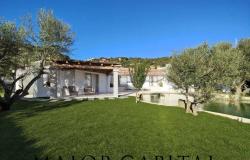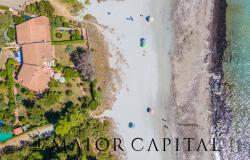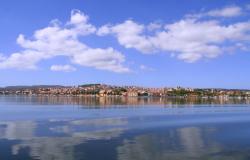 An ancient Phoenician colony on the western coast of Sardinia may soon yield some of its long-buried secrets during new excavations.
An ancient Phoenician colony on the western coast of Sardinia may soon yield some of its long-buried secrets during new excavations.
Othoca, founded by the Phoenicians some 2,600 years ago, partly evolved into the modern-day town of Santa Giusta but most remnants of the original settlement lie buried under a thick layer of mud at the bottom of a large lake.
Experts believe the lake, separated from the sea by a narrow bridge of land, was once the port of Othoca, used by the Phoenicians as a staging post on their maritime voyages.
Discussing the planned excavations, Santa Giusta Mayor Atonello Figus and an archaeologist from Cagliari University, Carlo Del Vais, said they would focus on a small section of the lake, just a few dozen square metres.
This area is believed to contain around a hundred amphorae, resting on top of a large quantity of processed wood.
The wood is remarkably well preserved thanks to the mineral content of the mud, which has slowed the normal deterioration process caused by oxygen.
Del Vais is hopeful that the wood is sufficiently well preserved to allow radiocarbon dating to be carried out at a lab in the United States.
Although plans for the excavations are in an advanced stage, much still depends on funding. The Culture Ministry is shortly expected to make the final decision on financing and the town is meanwhile trying to raise cash among private entities.
If approved, this would be the second major set of digs in the lake and the third in the area of Santa Giusta as a whole.
PREVIOUS DIGS UNCOVERED 50 AMPHORAE.
Earlier works uncovered 50 amphorae from the underwater mud, containing remnants of food and provisions.
In the 1980s, the remains of the Phoenician necropolis of Santa Severa in the town centre were unearthed. The excavation was considered a major breakthrough, as it revealed the only known example in Italy of a Phoenician underground chamber tomb, constructed with large slabs of sandstone.
Another tomb of the same type was identified a few dozen metres away. However, the excavation was called to a halt before reaching the site, as there were insufficient funds to ensure the preservation of any decorations and contents if unearthed.
The Phoenicians were a maritime trading people of the first millennium BC, who formed a massive commercial empire across the Mediterranean from their bases along the coast of modern-day Lebanon, Syria and Israel.
They founded a series of colonies as staging posts for their lengthy voyages, where they could stop to replenish provisions, shelter from storms and repair any damage to ships.
The most important Phoenician colony in the Western Mediterranean was at Carthage, in modern Tunisia, but they also established points along the Spanish coast and on the island of Sicily.
They started settling parts of Sardinia in the 8th century BC. Although initially staging posts, these soon developed into trade centres among the local peoples.
The native Sardinians were a peaceful farming people who quickly became friendly with the Phoenicians, as they lived inland, meaning there was no conflict over coastal land.











